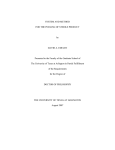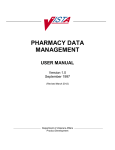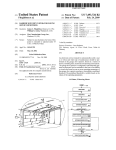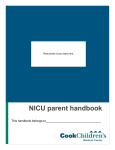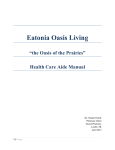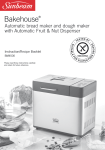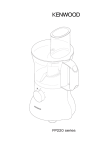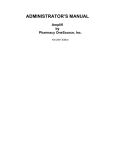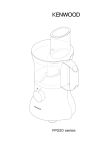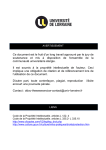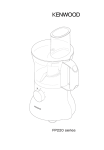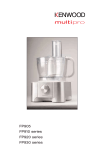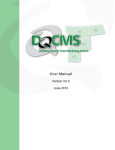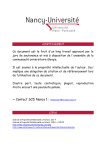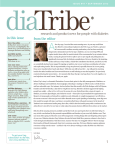Download The Medicines Schemes 1MB
Transcript
__________________________________ THE MEDICINES SCHEMES TABLE OF CONTENTS ___________________________________ Page Introduction Objectives Contents 5 6 7 Section 1 – The General Medical Services 8 Objectives Introduction The Primary Care Reimbursement Service The GMS Contract GMS Codes 8 8 9 9 10 Section 2 – GMS Prescriptions 11 Objectives Introduction Checking your GMS Prescriptions Coding your GMS Prescriptions 11 11 15 Section 3 – Repeat GMS Prescriptions 22 Objectives Introduction Dispensing the Repeat GMS Prescription 22 22 24 Section 4 – Hospital Emergency Prescriptions 25 Objectives Introduction Rules for Dispensing 25 25 26 1 Module 4 (Ireland) – Table of Contents Section 5 – Stock Orders 27 Objectives Dispensing Doctor’s stock order form Type 1 Dispensing Doctor’s stock order form Type 2 27 27 29 Section 6 – Dental Prescriptions 31 Objectives Introduction 31 32 Section 7 – Hardship Scheme 34 Objectives Introduction 34 34 Section 8 – Private Prescriptions 36 Objectives Introduction Unified Claim Form 36 36 37 Section 9 – The Drugs Refund Scheme 38 Objectives Introduction 38 38 Section 10 – The Drugs Payments Scheme 39 Objectives Introduction Registering for the DPS Notes on the Application Dispensing DPS Prescriptions Items Allowed on the DPS DPS Payments and Claims DPS Exercise 39 39 40 40 41 41 45 48 2 Module 4 (Ireland) – Table of Contents Section 11 – The Long Term Illness Scheme 49 Objectives Introduction Registering for the LTI LTI Payments and Claims 49 49 51 51 Section 12 – Health Amendment Act 53 Objectives Introduction Amendment Act Payments and Claims Exercise 53 53 54 55 Section 13 – European Prescriptions 56 Objectives Introduction EEA Prescriptions E128 Prescriptions 56 56 57 57 Section 14 – High Tech Medicines Scheme 59 Objectives Introduction Dispensing for the High Tech Scheme High Tech Payments and Claims 59 59 60 61 Section 15 – Methadone Scheme 62 Objectives Introduction Prescribing and Dispensing on the Methadone Prescription Form 62 62 63 Section 16 – Psychiatric Services Scheme Objectives Introduction Dispensing Psychiatric Services Prescriptions Submitting Psychiatric Services Prescriptions 70 70 70 71 71 3 Module 4 (Ireland) – Table of Contents Section 17 – Stoma Appliances 72 Objectives Introduction Colostomy Ileostomy Urostomy Appliances Accessories Problems Ostomy prescriptions Exercise 72 72 73 74 75 76 78 78 79 81 Section 18 – Incontinence Appliances 83 Objectives Introduction Managing Incontinence 83 83 83 Section 19 – Reagent Strips Objectives Introduction Testing for Glucose Testing for Ketones Other Reagents Exercise 85 85 85 85 86 87 88 Section 20 – Month’s End Procedures 90 Objectives Introduction Electronic Claims Manual Claims Submission Deadlines 90 90 91 93 99 4 Module 4 (Ireland) – Introduction ___________________________________________________________ THE MEDICINES SCHEMES ___________________________________________________________ Welcome to Module 4. This Module of the Pharmacy Technicians’ Course NVQ Level 3 is an account of the Medicines Schemes operating in Ireland. Before studying for this module on the Medicines Scheme in Ireland please check that you have access to the the following: • List of items allowed on GMS – Usually on the dispensary computer database. • PCRS List of Flat Rated Non Drug items Reimbursable under the GMS Scheme (these documents are sent to all pharmacies once a Year and the PCRS will not supply copies) • IPU Electronic Database Assessment of Module 4 will be through: • Intertext Questions which must be completed as you work through the Module and your supervising pharmacist has been provided with the answers. Remember, if in doubt, discuss the query with your pharmacist Multiple Choice Questions are completed at the end of the Module under examination conditions and the score reported back to the Professional Development and Promotion Unit on the Marking Form. After completing MCQ's the enclosed Case Studies need to be undertaken and the work submitted to your designated marker for assessing. Module 4 (Ireland) – Introduction 5 OBJECTIVES When you have studied this Module you will be able to: • Identify the roles and functions of the GMS Payments Board • Identify drug and non drug items that are allowed for payment under the various State Medicines Schemes by use of the GMS Codes and the IPU electronic database • Calculate payment entitlements under the various State Medicines Schemes • Identify patient eligibility to access a particular State Medicine Scheme • Ensure that you can carry out procedures to claim the relevant fees for exceptional item • Be aware of the different types of stoma and incontinence appliances • Be able to carry out the end of month procedures to process GMS claims electronically and manually 6 ______________________________________ CONTENTS ______________________________________________ Section 1: The General Medical Services ¾ HOUR Section 2: GMS Prescriptions 2 ½ HOURS Section 3: Repeat GMS Prescriptions ¾ HOUR Section 4: Hospital Emergency Prescriptions ½ HOUR Section 5: Stock Orders ½ HOUR Section 6: Dental Prescriptions ¾ HOUR Section 7: Hardship Scheme ½ HOUR Section 8: Private Prescriptions ¼ HOUR Section 9: The Drugs Refund Scheme ¼ HOUR Section 10: The Drugs Payments Scheme 2 HOURS Section 11: The Long Term Illness Scheme ¾ HOUR Section 12: Health Amendment Act ¾ HOUR Section 13: European Prescriptions ¾ HOUR Section 14: High Tech Medicines Scheme ¾ HOUR Section 15: Methadone Scheme 1½ HOURS Section 16: Psychiatric Services Scheme 1 HOUR Section 17: Stoma Appliances 1½ HOURS Section 18: Incontinence Appliances ¼ HOUR Section 19: Reagent Testing Strips 1 HOUR Section 20: Month’s End Procedures ¾ HOUR 7 Module 4 (Ireland) – Section 1 ________________________________________________________________ Section 1 The General Medical Services ________________________________________________________________ This section should take you approximately THREE QUARTERS of an HOUR to complete. OBJECTIVES By the end of this section you should understand: • • • • • what the GMS means who is eligible for GMS services what the roles and functions of the PCRS are what is meant by a GMS contract what information is contained in the GMS codes INTRODUCTION If you’ve been working in a pharmacy for a while you’ll be familiar with the General Medical Services, or GMS. The purpose of the GMS is to provide full pharmaceutical, medical and surgical services free of charge to: • Anyone who qualifies under the current entitlement rules. There is no fixed income limit applied to this, but there are means test guidelines. • Anyone over seventy years of age, who are eligible after a means test. 8 Module 4 (Ireland) – Section 1 In order to qualify for services under the GMS a person has to send an application to the health board, stating their income from all sources The health board then decides on the application, and those who are successful are issued with a medical card. Medical card holders then chose a doctor from a list of GPs practising in their area. While they must attend this GP, they are free to have their medicines dispensed in any pharmacy which participates in the GMS scheme. THE GMS - PCRS The GMS is administered by a body called the Primary Care Reimbursement Service (PCRS), which is based in Exit 5, M50, North Road, Finglas, Dublin 11. Its main function is to make payments to pharmacists, doctors and dentists for services provided under the GMS scheme. The PCRS is responsible for: • • • • Calculation of payments for these services Making payments Verification of the accuracy and reasonableness of claims Compilation of statistics and other information in relation to these services THE GMS CONTRACT Any pharmacy which wishes to provide services to GMS patients must hold a GMS contract. These contracts are issued by the health boards and were changed in July 2009. We will not deal with the GMS contract in detail here. Instead we will examine how the GMS works, and how it’s administrative and other procedures affect your work in the pharmacy. 9 Module 4 (Ireland) – Section 1 GMS CODES UNLESS AN ITEM HAS A GMS CODE IT WILL NOT BE PAID FOR BY THE GMS This means that when you get a GMS prescription you need to check whether all the items on it are allowed. Any that aren’t can still be dispensed, but the pharmacy won’t be paid for them. If your pharmacy has a dispensary computer system, then all the GMS allowable items will be indicated on the system as such, and their five digit GMS code numbers will also be on the system. Each month you will get your IPU price disc update. This is very important, because as well as updating the prices on your computer, it also contains all of the amendments to GMS coding. Write down how you update the IPU product file disc on your pharmacy’s computer? Look at the IPU product file on your pharmacy’s computer and write down the GMS code for: Exocin eye drops Diovan 80mg tablets Depo-Medrone Injection 10 Module 4 (Ireland) – Section 2 Section 2 GMS PRESCRIPTIONS ___________________________________ This section should take you approximately TWO and a HALF HOURS to complete. OBJECTIVES By the end of this section you should understand: • • • • • • • • what a GMS prescription form is, and what it looks like how to check a GMS prescription to see it is properly written what important medical card details need to appear on the prescription what is meant by allowable GMS items, and how to check a prescription for these how to ensure all the required details on a GMS prescription are completed how to code GMS prescriptions, and how to deal with special cases like generics, decimals, conversions and items for which restricted quantities are required how to dispense and code special case GMS prescriptions where dispensing is afterhours, in a number of phases, or where items are not dispensed INTRODUCTION When a doctor wants to prescribe something for one of his GMS patients he has to write the prescription on a special GMS prescription form. An example of one of these is shown below. 11 12 Module 4 (Ireland) – Section 2 CHECKING YOUR GMS PRESCRIPTIONS Let’s look a bit more closely at what you need to check on receiving the prescription. 1. IS THE PRESCRIPTION PROPERLY WRITTEN? You always need to check that the prescription complies with all the legal requirements that we looked at in module 3. Go back to the Section in Module 3 on prescription writing requirements. Take a few minutes to look over these requirements again. 2. DOES THE PATIENT HAVE A MEDICAL CARD, AND IS THE NUMBER ENTERED ON THE PRESCRIPTION? Whenever a new patient presents with a medical card prescription you should make sure to take down their medical card number. Enter these on the patient’s PMR on your computer, so you’ll have them for reference purposes later on. The patient’s medical card number needs to be on the prescription. If it isn’t, then the PCRS will not pay you for the prescription. If the number is wrong you can either leave it as it is (the PCRS will pay you even if the prescriber has entered the number wrongly) or you can correct it yourself. But be careful. If you enter a different GMS number, and you happen to get it wrong the PCRS won’t pay you for the prescription. Finally, you might come across prescriptions with the letters STC written in the section for medical card number. This just means ‘special type consultation’. This means that the patient has not yet been issued with their medical card, but has been accepted onto the GMS. 13 Module 4 (Ireland) – Section 2 Write down details of two places you can check a patient’s GMS number if it is not on the PMR or the prescription: 1. 2. 3. ARE ALL THE ITEMS ON THE PRESCRIPTION ALLOWABLE ON THE GMS? Later on in this section we’ll be looking in detail at what is and isn’t allowed on the GMS. For the moment, you just need to be aware that some things are allowed, and some aren’t. If the prescription contains items not allowed on the GMS the patient could either bring it back to their doctor to have something else prescribed, or they could elect to pay for the prescribed item. 4. ARE ALL THE DETAILS ON THE PRESCRIPTION COMPLETE? Sometimes the doctor might not enter some essential details like the dosage, quantity or strength of the medicine to be supplied. If this happens you should try to contact the prescriber and clarify the missing details. The pharmacist must then write on the prescription the amended details supplied by the doctor, together with a note stating that the prescriber was contacted to verify these details. The abbreviation ‘PC’ may be used for ‘prescriber contacted’. If the prescriber can’t be contacted then the pharmacist will have to use his own professional judgement to prescribe the prescription according as he sees fit. He will have to write on the prescription what he has done, along with a note saying that he tried to contact the prescriber but was unable to do so. The abbreviation ‘pnc’ may be used for ‘prescriber not contacted’. 14 Module 4 (Ireland) – Section 2 CODING YOUR GMS PRESCRIPTIONS Once you’ve dispensed the prescription, if you do not send your claims electronically, you need to enter on it the GMS numbers and the quantities of the items dispensed. In most cases this is straightforward enough. Most medicines and appliances have their own individual code number, so you enter this along with the quantity of items dispensed. Each specific pack of each product or standard preparation has a unique fivefigure code. This code identifies the product or item dispensed. Quantities of less than 10,000 computer units dispensed on a prescription, claim form or stock order form MUST be indicated by the use of four digits. When the quantity supplied is less than 1,000 leading zeroes MUST be used, eg 0001, 0005, 0050, 0100. Write down the GMS numbers for the following items: Adalat Retard 10mg Tablets Duphalac Liquid 1Litre Flixotide 250mcg evohaler Depot Medrone Injection 40mg/ml Allevyn Dressings 12.5cm x 12.5cm Ask your pharmacist to check your answers. There are some special cases where coding prescriptions isn’t quite so simple: 1. .UNCODED MEDICATIONS There are some items which are allowed on the GMS, but don’t have GMS numbers. These are mainly ostomy and urinary appliances. ( We’ll be looking at these in a later section). 15 Module 4 (Ireland) – Section 2 2. CONVERSIONS All GMS coding is based on the metric system. If you do get a prescription expressed in imperial quantities such as drachms, ounces and pounds there are special instructions and formulae on converting these to metric equivalents. Ask your pharmacist to show you some of these conversions. 3. .EXTEMPORANEOUS PREPARATIONS An extemporaneous preparation is one made up in the pharmacy. Doctors will Occasionally prescribe these, but they are far less common than they used to be. If you do come across a prescription for an extemporaneous item then there are some special GMS rules to follow. For extemporaneous dispensing of oral medication the GMS code is 99159For extemporaneous compounding and dispensing of powders the GMS code is 99160 For extemporaneous dispensing of ointments or creams the code is 99161 A description of the preparation dispensed, including the quantity of each ingredient is also required. 4. GENERIC PRESCRIBING If the doctor prescribes a generic equivalent of a medicine and specifies either the manufacturer’s name or the generic brand name you MUST dispense this, and code it as appropriate. You can’t just substitute a different generic yourself – the pharmacist may do so if in his professional judgement it is appropriate to do so. Sometimes the prescriber will prescribe a brand name of a medicine, but stamp it ‘or generic equivalent’. You can then dispense a generic equivalent. 16 Module 4 (Ireland) – Section 2 If the doctor prescribes a medicine by its generic name and does not specify either a brand name or manufacturer’s name then you are expected to dispense one of the less expensive generics available. The PCRS publish information on relative cost of generics from time to time and you can also use your IPU price list or your dispensary computer to check the relative cost of different generics. Be sure to dispense and code for one of the lower cost alternatives. Write down the cost price of the following branded medicines, two examples of generic alternatives, and the cost of the generic medicines: Brand Cost price Generic 1 Cost price Generic 2 Cost price Ventolin Inhaler Klacid LA 500mg tablets Zoton 30mg Tablets Ask your pharmacist to check your answers. 17 Module 4 (Ireland) – Section 2 5. PHASED DISPENSING Sometimes a doctor will ask on the prescription to have a medicine dispensed in phases. The PCRS will allow you a special phased dispensing fee for this, and the fee will be paid for each dispensing necessary after the first dispensing of the item. Phased dispensing will usually take place for the following reasons: a. At the request of the patient’s doctor. b. If the stability or shelf life of the medicine requires it, an example being a prescription for Augmentin Junior, 5mls to be taken each day for a month. Reconstituted Augmentin Junior has to be discarded after one week. c. A small initial supply is to be dispensed to establish the patient’s tolerance to the medication before commencing a full course of treatment. d. The patient is not considered to be capable of safely and effectively managing their medication. You might come across this where a doctor is treating someone who may be dependent on benzodiazepines or other habit forming drugs? You must make sure to endorse the prescription to show you have dispensed this item in phases. This is done by entering the FULL QUANTITY DISPENSED against the GMS Drug Code, and on the line underneath entering the appropriate phased code indicating HOW MANY ADDITIONAL PHASED DISPENSINGS are being claimed. The phased dispensing codes are: a. At the doctor’s request 889_ _ b. Stability or shelf life of the medicine requires 888_ _ c. A small initial supply 887_ _ d. Patient safety 886_ _ Take a look at the GMS prescription below. The doctor has asked for the medicine to be dispensed in four lots, and it is coded as shown. 18 Module 4 (Ireland) – Section 2 If your GMS claims are made electronically you will follow the instructions of your pharmacy computer system for phased dispensing. .LATE DISPENSING If the doctor marks the prescription URGENT and it is received and dispensed by the pharmacist after hours then a late dispensing fee may be claimed. After hours means any time outside the opening times of the pharmacy as stated on the pharmacy’s GMS contract. Remember that you should have your opening times posted clearly in the pharmacy. The prescription should be marked with the time and date of dispensing. THE NON-DISPENSING FEE In certain circumstances the pharmacist might decide that it is not in the best interests of the patient to dispense an item indicated on their GMS prescription. He then enters the non-dispensing code 79999 and leaves the quantity column blank. He must also endorse the prescription with a hand written note explaining why the item was not dispensed. 19 Module 4 (Ireland) – Section 3 RESTRICTED QUANTITY ITEMS There are a number of items for which only a certain quantity is reimbursable under the GMS, regardless of the quantity prescribed. These quantities are the maximum you will be paid for, even if you dispense more. VIAGRA, CIALIS AND LEVITRA The maximum reimbursable quantity of either viagra, cialis or levitra tablets is 4 per patient per month. A patient may be dispensed 4 viagra, 4 cialis or some combination of both not in excess of 4 (eg, 1 Viagra and 3 cialis). NICOTINE-REPLACEMENT THERAPY (NRT) The initial quantity of NRT prescribed for a patient is limited to a two-week supply, in order to evaluate the effectiveness of the therapy. A month’s supply can be dispensed thereafter. NRT may only be prescribed on a single GMS form. NRT prescribed on the repeat GMS form will not be paid for. THE UNLICENSED MEDICINES (ULMs) LIST Unlicensed medicines are medicines that do not have a product licence in Ireland. They should only be prescribed when a licensed product is not available and the prescription should be initiated by a consultant. Previously, a patient had to apply to their local health office to seek approval for all ULMs to be dispensed under the Hardship Scheme (see section 7), but, in April 2010 the HSE issued a list of ULMs (exempt medicinal products) that no longer required individual authorisation by the local area health office when dispensing to medical card patients. These ULMs have been given a drug code. 20 Module 4 (Ireland) – Section 3 The ULMs on this list should be prescribed on a GMS prescription and the listed drug codes entered on the GMS prescription when dispensed. A relevant invoice should be attached to these prescriptions which should then be submitted in the normal manner with your other GMS prescriptions to the PCRS at the end of the month. ULMs not on this list will still require approval by the local health office to be dispensed under the Hardship Scheme (see section 7). Ask your pharmacist to show you the ULMs list and write down the drug code for the eight ULMs listed below: ULM Drug code Anoheal cream 2% Optimax tablets 500mg Eldepryl syrup 10mg /5ml Tranxene capsules 5mg Voltarol suppositories 25mg Scopoderm TTS patches 1.5mg Nystaform HC ointment 1% Miconazole eye drops 1% 21 Module 4 (Ireland) – Section 3 ___________________________________ Section 3 Repeat GMS Prescriptions ___________________________________ This section should take you approximately THREE QUARTERS of an HOUR to complete OBJECTIVES By the end of this section you should understand: • • • what a repeat GMS prescription is what a repeat GMS prescription looks like, when it is used, and what items can be included on it how to dispense a repeat GMS prescription INTRODUCTION A doctor may prescribe a maximum of three months’ treatment for a medical card patient on a special repeat GMS prescription form, an example of which is shown on the next page. The prescriber must write ‘repeat x 2’ on the top copy. The repeat GMS prescription should NOT be used for either CD2 or CD3 controlled drugs, nicotine replacement therapy products or items which are only to be prescribed once. 22 23 Module 4 (Ireland) – Section 3 Write down six examples of medicines that should not be prescribed on the repeat GMS form: 1. 2. 3. 4. 5. 6. DISPENSING THE REPEAT GMS PRESCRIPTION The repeat GMS prescription form is a six-part form, two parts to each dispensing. Each of the instalments can be dispensed at any pharmacy. When you have dispensed the first month’s instalment you keep the bottom two copies, stamp the top copy and write the date of dispensing on it and return the remaining copies to the patient. You then code the bottom two copies as you would for an ordinary GMS prescription. The pharmacist must sign it in the appropriate place. The same procedure applies on the second dispensing, where you keep the bottom two copies, and return the remaining two copies to the patient. At the month’s end all repeat GMS prescriptions need to be collected together, numbered and submitted to the PCRS along with the single GMS prescriptions. 24 Module 4 (Ireland) – Section 4 ___________________________________ Section 4 Hospital Emergency Prescriptions ___________________________________ This section should take you approximately HALF an HOUR to complete. OBJECTIVES By the end of this section you should understand: • • • • what a hospital emergency prescription is who can prescribe a hospital emergency prescription and for whom how to dispense a hospital emergency prescription special rules to be aware of when dispensing hospital emergency prescriptions INTRODUCTION Where a medical card patient has been discharged from an Acute General Hospital or has attended the Accident and Emergency Department (Casualty) of a General Hospital they may have been issued with a prescription. Hospital doctors are not part of the GMS, so this prescription would not be valid for dispensing under the GMS scheme. 25 Module 4 (Ireland) – Section 4 The patient can bring the prescription to their GP, who will then transfer the prescription details onto a GMS form, which can then be dispensed. Alternatively, the patient may have the hospital prescription dispensed free of charge under the terms of the hospital emergency provisions. These are as follow: RULES FOR DISPENSING If the patient is discharged at the weekend, late in the day, or outside of normal surgery hours then the pharmacist may dispense a MAXIMUM OF SEVEN DAYS SUPPLY as an emergency hospital prescription under the GMS. The procedure for this is as follows: 1. The patient must have a valid medical card which you are required to make sure is in date. The patient should show you evidence of this. 2. The prescription may only be dispensed on the day of issue, or in special circumstances within 24 hours of issue. 3. The hospital must be a participant in the hospital emergency scheme (The PCRS has a list of all the participating hospitals, make sure you have this list available in your pharmacy) 4. The pharmacist must complete a unified claim form, indicating the patient’s details and the quantity and codes of all items dispensed. 5. A photocopy of the prescription is attached to the claim form. The original prescription is returned to the prescription or retained in the pharmacy as appropriate. 6. The doctor code is entered as 61559 7. Where a generic equivalent of the prescribed medicine is available then the generic should be dispensed. 8. The completed claim form is signed by the patient and pharmacist and submitted at the month’s end to the PCRS. Hospital emergency prescriptions are not for out-patient visits 26 Module 4 (Ireland) – Section 5 __________________________________ Section 5 Stock Orders ___________________________________ This section should take you approximately HALF an HOUR to complete OBJECTIVES By the end of this section you should understand: • • • when a doctor might use a stock order form what the different type of stock order forms are, what they look like, and the different things they are used for how to dispense a stock order TYPE 1 – DISPENSING DOCTOR’S STOCK ORDER FORM In certain cases a doctor may dispense medicines for his own medical card patients. The doctor gets his medicines from a pharmacy within his area of practice by using a Stock Order (SO) form. A sample SO form is shown on the next page. This is called a Type 1 or ‘White SO form’’ The SO form is a four-part copy form. When the doctor has filled in the form he keeps the bottom (fourth) copy for himself and submits the remaining three copies to the health board office. The health board then retains the third copy and forwards the remaining two copies to the pharmacy nominated by the doctor. The pharmacy then supplies the items required to the doctor, and the doctor signs the SO to verify he has received the items. 27 Module 4 (Ireland) – Section 5 The pharmacy keeps the second copy and submits the original top copy to the PCRS for payment. Only items supplied on or after the date on which the SO is received by the pharmacy will be reimbursed by the PCRS. Your pharmacy will be paid for Type 1 SOs as follows: Ingredient cost + 20% mark up + VAT 1. TYPE 1 – DISPENSING DOCTOR’S STOCK ORDER FORM (WHITE) GENERAL MEDICAL SERVICES 28 Module 4 (Ireland) – Section 5 TYPE 2 – SYRINGE/NEEDLE/DRESSING STOCK ORDER FORM If you’ve been looking through your GMS code book you’ll have seen that there are lots of syringes, needles and dressings allowed on the GMS. These are listed in what is called the GMS flat rate price list. This means that the PCRS will only reimburse you at the stated price, even if a higher cost item has been dispensed. You have to be careful that you dispense and code prescriptions and stock orders for these Type 2 items correctly. Most of them will be flat price rate items. As well as prescribing these items for patients, doctors also keep stocks of them for use in their surgeries. They obtain these by way of a Type Syringe/Needle/Dressing Stock Order Form, a sample of which is shown on the next page. This is sometimes called a Pink SO form. The Pink SO form is used to supply: 1. 2ml, 2.5ml, 5ml, and 10ml non-insulin disposable syringes, with or without needles. 2. Dressings for use in doctor’s surgery which are included in the list of dressings paid for by the PCRS. Your pharmacy will be paid for Type 2 SOs as follows: Ingredient cost + 20% mark-up + VAT 29 30 Module 4 (Ireland) – Section 6 ___________________________________ Section 6 Dental Prescriptions __________________________________ This section should take you approximately HALF an HOUR to complete OBJECTIVES By the end of this section you should understand: • • • what a DTSS prescription is what a DTSS prescription looks like, when it is used, and what items can be included on it how to dispense, code and claim for a DTSS prescription INTRODUCTION There is a special section of the GMS called the Dental Treatment Services Scheme (DTSS). Under the DTSS medical card patients over the age of 16 are also entitled to free dental treatment (once their dentist is participating in the DTSS). The dentist can prescribe medicines, but only if they are included on the Dental Formulary. A special prescription form is used, and a sample of this is shown on the next page. The patient can attend any pharmacy with a GMS contract. You can see from this that the DTSS or Dental prescription is very similar to the GMS prescription. In terms of coding and completing the form the procedure is the same as for GMS forms. If your pharmacy submits claims electronically you must write the GMS codes on the dental prescription. 31 Module 4 (Ireland) – Section 6 32 Module 4 (Ireland) – Section 6 Indicate with a tick which of the following medicines are allowed on the DTSS: Voltarol Retard 75mg tablets Amoxil 250mg capsules Anxicalm 2mg tablets Distaclor 125mg/5ml suspension Motilium 10mg tablets Flagyl S suspension Metronide 200mg tablets Tegretol Retard 200mg tablets Melfen 400mg tablets Zovirax cream 2g Augmentin Duo 35ml Hydrocortisyl cream Pethdine 50mg injection 33 Module 4 (Ireland) – Section 7 Section 7 Hardship Scheme ___________________________________ This section should take you approximately HALF an HOUR to complete . OBJECTIVES By the end of this section you should understand: • • who is entitled to avail of the hardship scheme, and when how to dispense and claim payment for a hardship prescriptions INTRODUCTION As you will be well aware now, there are certain items prescribed on a GMS prescription which are not allowed under the GMS scheme. In certain instances a patient’s medical status might require that he or she be prescribed a medicine which does not have a GMS code (a non-reimbursable item). If this happens the patient can apply to the local health board under the terms of the hardship scheme to have the prescribed items dispensed free of charge. The pharmacy will be asked by the health board to complete a form indicating the cost of the prescribed drug. If the health board approves this application then the pharmacy is notified and permission granted to dispense the required medicines. These hardship scheme prescriptions should be sent directly to the local health board for payment, along with a copy of the relevant invoice. 34 Module 4 (Ireland) – Section 7 Your pharmacy will be paid for Hardship Scheme prescriptions as follows: Ingredient cost + Fee (currently €5 (2012)) + VAT (if applicable) List three medicines that are dispensed in your pharmacy under the Hardship Scheme: 1. 2. 3. 35 Module 4 (Ireland) – Section 8 ___________________________________ Section 8 Private Prescriptions ___________________________________ This section should take you approximately a QUARTER of an HOUR to complete. OBJECTIVES By the end of this section you should understand: • • • what the difference between GMS and private prescriptions is what types of private prescriptions there are how unified claim form works INTRODUCTION We have already looked at the GMS scheme and how it works. You’ll remember that certain people are entitled to treatment under the GMS scheme. For those not entitled to services under the GMS scheme there are a variety of other schemes under which they might receive their medicines and other prescription items. For convenience we will refer to all these schemes collectively as ‘private’. These schemes are: • • • • • Drug Refund Scheme Drug Payments Scheme Long Term Illness Scheme Health Amendment Act Psychiatric Services 36 Module 4 (Ireland) – Section 8 UNIFIED CLAIM FORM All the different private prescription schemes use the unified claim form. A sample of this is shown below: Any time you dispense something on one of the private prescription schemes you need to enter all the details on one of these forms. This is usually automatically generated by the dispensary computer system. After dispensing the patient signs the form to verify that they have received the medicines indicated on the form. 37 Module 4 (Ireland) – Section 9 ___________________________________ Section 9 The Drugs Refund Scheme ___________________________________ This section should take you approximately a QUARTER of an HOUR to complete OBJECTIVES By the end of this section you should understand: • • • what the DRS is how to dispense DRS prescriptions, and how to complete the DRS claim form important dates for submission of DPS claims INTRODUCTION The Drugs Refund Scheme (DRS) is the way anyone who is not in the GMS or any of the other private schemes has their medicines dispensed. It works as follows. The patient can have their prescription dispensed at any pharmacy, and they are given a DRS receipt in the form of a unified claim form detailing all the items that have been dispensed, and the price paid for these. Drugs Refund Scheme prescriptions are priced as follows: Ingredient cost + mark up + Fee + VAT (if applicable) The patient (and any qualifying member of their family) can then claim back from the Health Board any expense in excess of the designated threshold they have paid for prescribed medicines and appliances in any one calendar month. Refund application forms are available from the health board. 38 Module 4 (Ireland) – Section 10 ___________________________________ Section 10 The Drugs Payments Scheme ___________________________________ This section should take you approximately TWO HOURS to complete. OBJECTIVES By the end of this section you should understand: • • • • • • • • • • what the DPS is who can apply for the DPS how to register with the DPS special conditions to be met when applying to the DPS how to dispense DPS prescriptions, and how to complete the DPS claim form what items are allowed on the DPS special instructions regarding quantities to be dispensed on the DPS how DPS payments are calculated how to submit DPS claims important dates for submission of DPS claims 39 Module 4 (Ireland) – Section 10 INTRODUCTION The Drugs Payments Scheme (DPS) is open to anyone ordinarily registered in the state who is not covered by the GMS or LTI schemes. It works as follows: The family; which is the individual, his or her spouse or partner, and any dependents pays the pharmacy the designated cost per month of all prescribed medicines and appliances. Any excess is then claimed directly from the PCRS by the pharmacy. Since January 2012 this cost is €144.00 per month. ‘Dependents’ include children under 18, anyone between 18 and 23 who is in full time education and anyone, regardless of age, with a physical or mental disability or a mental handicap or illness who cannot maintain themselves fully, is ordinarily resident at the address and doesn’t have a medical card. At the moment the DPS requires that all medicines in respect of any one month must be dispensed from one pharmacy. If a prescription is obtained from another pharmacy for the same month payment up to the designated limit must also be made to this pharmacy. However, the patient may claim back this excess payment by submitting their receipts (unified claim forms) to the HSE. REGISTERING FOR THE DPS Anyone who wishes to register with the DPS must complete an application form, which is available from the Health Board and from pharmacies. You can give these to patients who wish to apply to the scheme. The claimant needs to enter their: • • • • Name and address (all the applicants must live at the same address) The name of each person they wish to have included on the DPS The PPS number of each person they wish to have included on the DPS The date of birth of each person they wish to have included on the DPS NOTES ON THE APPLICATION The applicant needs the PPS number of each person they wish to have included in the scheme. PPS numbers for children can be obtained from the Department of Social, Community and Family Affairs. 40 Module 4 (Ireland) – Section 10 The application form is then returned to the health board, and in due course the patient will be issued with an authorisation card showing their: • • • • • Name date of birth DPS number expiry date of card name of issuing health board DISPENSING DPS PRESCRIPTIONS Once someone presents you with a prescription and tells you that they are in the DPS scheme you should ask for their authorisation card. All DPS claims need to have the patient’s DPS number on them, so be sure to note the DPS number in the patient’s PMR file, along with the expiry date. You then dispense the prescription and complete the required details on the unified claim form. Two copies of the claim form need to be made – one is given to the patient, the other you keep and use to claim from the PCRS at the end of the month. If someone is not registered for the DPS, but wants to have a prescription dispensed you can get them to fill in the emergency application form in the pharmacy (they MUST have their PPS number). You then send the top copy of the application form to the local health board and attach the bottom copy to the unified claim form to send to PCRS at the end of the month. ITEMS ALLOWED ON THE DPS The following items are allowed for reimbursement on the DPS (note that they have to have been prescribed for the patient): • • • • Any medicine or appliance which has a GMS code number Incontinence wear Certain Dressings Certain Unlicensed medicines (listed on the ULMs list), see below. 41 Module 4 (Ireland) – Section 10 The DPS operates on a calendar month system, and the patient must pay up to the designated amount of the cost of their prescribed drugs or appliances per month. You should make sure to dispense an appropriate quantity of medicines, especially in the case of someone who is on long term repeat prescription. For example, if a patient is taking say an antihypertensive, which comes in calendar packs of 28 tablets, you should dispense an appropriate quantity for the month in question – usually 30 or 31 tablets. Furthermore, it is important to note that the PCRS will only reimburse you for treatment for a particular month so you should only dispense a quantity suitable for a one month period of treatment. Suppose you are given a prescription for Lyrica 50mg capsules, one twice daily for three months. The patient gives you his DPS card and asks if he can have all three months dispensed together. What would you do? 42 Module 4 (Ireland) – Section 10 Remember that the DPS operates on a monthly basis. The prescription is for one tablet daily, so you’ll only be reimbursed for a maximum of 31 tablets in any one claim period. You could dispense the whole three months, and submit one claim for each relevant month, but you will have to ask the patient to pay the three monthly fees. Look at the sample prescription below. Assuming you dispense this prescription, complete the required details on the claim form on the next page. You can take it that this is your first form of the month, so your form number is 1. You can also take it that the patient has a valid DPS card, his number is 123456 B A, and you’re dispensing the prescription on the day it was written. Dr Fergus Fitzgibbon The Square, Listowel, Co Kerry Tel: 064 123456 Manus O’Brien Ballymain Co Kerry 10/6/2011 Rx Teveten 400mg tabs, one daily Lipitor 40mg tabs, one daily Nu-seals Aspirin 75mg tabs, one daily Repeat x 5 Fergus Fitzgibbon MB 43 44 Module 4 (Ireland) – Section 10 DISPENSING UNLICENSED MEDICINES UNDER THE DPS As previously mentioned in section 7 there is a list of ULMs which can be dispensed under the GMS. ULMs should only be prescribed and dispensed when a licensed alternative is not available. ULMs on the ULMs list have a code and can be dispensed under the DPS in the same way as licensed medicines. Before dispensing ULMs without a code check with the PCRS that the item will be covered by the scheme and attach a copy of the invoice for the medicine to the unified claim form. DPS PAYMENTS AND CLAIMS Your pharmacy will be paid for dispensed DPS prescriptions as follows: Ingredient cost + 20% mark up + Dispensing fee + VAT (if applicable) The dispensing fee is inclusive of broken bulk and container allowance. Look back at the DPS claim form you completed on the last page. Now, using the ingredient cost from the IPU price list, the DPS dispensing fee and VAT of 0% for oral medicines, calculate the amount you would claim for each of these items, and insert it in the far right hand column of the unified claim form above. Check your answer by processing this prescription through your computer, and printing out the two DPS receipts. 45 Module 4 (Ireland) – Section 10 DISPENSING EXTEMPORANEOUS PRODUCTS UNDER THE DPS The PCRS supplies each pharmacy with a list of extemporaneous dispensing fees, and codes for claiming extemporaneous products under the various medicine schemes. Ask your pharmacist to show you this list and write down the codes for the following extemporaneous products dispensed under the DPS: 1. 30g hydrocortisone 1% cream 15g in silcocks base 2. 300g coal tar 2% in emulsifying ointment 3. 100ml captopril 5mg in 5ml suspension 4. 200ml eltroxin 10mg in 5ml suspension 46 Module 4 (Ireland) – Section 10 At the end of the month you have to collect all your DPS claim forms together, and number them sequentially (if you have generated the claim forms using your computer they’ll be automatically numbered for you). Check that each form is correctly completed, and then separate them into two bundles, one bundle comprising of forms for which the patient has not exceeded the designated threshold and another for those forms for which the patient has exceeded the designated threshold. Remember to take into account all qualifying family members and dependants when you’re working out whether a patient has exceeded the threshold. ULMs which do not have a code should be bundled together. These are known as DPS exceptions (see section 20). ONLY those forms in respect of patients (or families) which have EXCEEDED the designated threshold should be submitted to the PCRS. The PCRS will then subtract this amount from the total amount – remember that the patient has already paid this to you – and you will be paid the rest. You will also receive a statement indicating what you have been paid for in respect of each form, and also details of any claims which were rejected due to incomplete, missing or invalid information. You need to check your statement carefully to ensure that the correct payments have been made, and make sure to reply to the PCRS regarding any rejected claims as quickly as possible. Electronic claims should be submitted to the PCRS by the 3rd working day of the month following dispensing and the pharmacy will receive payment on 21st or 22nd day of that month. Manual claims should be submitted by the 7th day of the following month. You will also receive a statement indicating what you have been paid for in respect of each form, and also details of any claims which were rejected due to incomplete, missing or invalid information. Check your statement carefully to ensure that the correct payments have been made, and make sure to reply to the PCRS regarding any rejected claims as quickly as possible. 47 Module 4(Ireland) – Section 10 EXERCISES – DPS 1. What items, in addition to those drugs and appliances with GMS numbers are allowed on the DPS? 2. If you want to submit your claim to the PCRS electronically, when must it be in by? 3. Mrs Browne, a regular customer, tells you she wants to apply for the DPS card and asks you if the following members of her family would be eligible for inclusion. Would they? (i) Her husband (ii) Her daughter, Patricia aged 22, who is a full time student (iii) Her Son, Matthew aged 19, who works full time 48 Module 4 (Ireland) – Section 11 ___________________________________ Section 11 The Long Term Illness Scheme _______________________________________________________ This section should take you approximately THREE QUARTERS of an HOUR to complete. OBJECTIVES By the end of this section you should understand: • what the LTI is • who is entitled to services under the LTI, and how they register • the payment rates, claims procedure and submission dates for the LTI INTRODUCTION The Long Term Illness Scheme (LTI) is open to anyone who suffers from certain chronic illnesses. These are: • • • • • • • • • • • • • • • • Diabetes insipidus Diabetes mellitus Cerebral palsy Cystic fibrosis Epilepsy Haemophilia Hydrocephalus Spina bifida Acute leukaemia Multiple sclerosis Muscular dystrophy Parkinsonism Phenylketonuria Mental handicap Mental illness in children under 16 Conditions arising from use of Thalidomide 49 Module 4 (Ireland) – Section 11 Patients registered with the LTI scheme can have any medication prescribed for their condition dispensed to them free of charge. In addition, diabetic patients can have medication for hypertension and hypercholesterolaemia dispensed free of charge (The items allowed under this provision are antihypertensives, diuretics, beta-blockers, calcium channel blockers, agents acting on the renin-angiotensin system and serum lipid reducing agents).If patients registered for the LTI scheme also have a medical card all the medications that have a GMS code must be prescribed on a medical card prescription and dispensed under the GMS scheme. Give an example of a medicine allowed on the LTI scheme for diabetic patients from each of the following drug classes: 1. Antihypertensive 2. Diuretics 3. Beta-blockers 4. Calcium channel blockers 5. ACE inhibitor 6. Hypercholesterolaemia Check your answers with your pharmacist 50 Module 4 (Ireland) – Section 11 REGISTERING FOR THE LTI In order to register with the LTI the patient’s doctor must complete an application form. Remember that to qualify for the scheme patients MUST be diagnosed as suffering from one of the indicated conditions which is then sent to the health board. The patient is then issued with an LTI book, showing their registered number. Once they are registered with the scheme patients can have their medicines dispensed at any pharmacy, at any time. The Long Term Illness Scheme does not depend on income or other circumstances and is separate from the Medical Card scheme and the GP Visit Card Scheme. ULMs DISPENSED UNDER THE LTI SCHEME The procedure for dispensing ULMs, that the health board have agreed to cover for the patient, is the same as for the DPS. Look back at section 10. Any ULMs not on the ULMs list will not have a drug code. These are bundled together and claimed for under ‘LTI exceptions’ EXTEMPORANEOUS PRESCRIPTIONS The procedure for dispensing extemporaneous prescriptions under the LTI scheme is the same as for the DPS. Look back at section 10. LTI PAYMENTS AND CLAIMS The payment rates, claims procedure, claims submission dates, payment dates and for dealing with rejected claims are the same for the DPS scheme. Have a quick look back to see how the claims procedure for the DPS works. 51 Module 4 (Ireland) – Section 11 Now have a look at the sample prescription below. Assuming the patient is a registered LTI patient, what illness do you think they might be suffering from? Would all the items on the prescription be allowed on the LTI scheme? DR. PHILIP P. DONNELLY, SUITE 104, THE BLACKROCK CLINIC, CO. DUBLIN. TEL: (01) 1234567 Helen Jones 3 June 2011 Port Rd, Letterkenny, Co. Donegal Rx Sinemet CR, sig 1 bd Parlodel 2.5mg tabs, sig 1 tid Repeat x 5 Philip Donnelly MB If this patient was prescribed a course of Amoxicillin 500mg tds for 5 days, what scheme would this be dispensed under? Check your answers with your pharmacist. 52 Module 4 (Ireland) – Section 12 Section 12 Health Amendment Act This section should take you approximately THREE QUARTERS of an HOUR to complete OBJECTIVES By the end of this section you should understand: • • • what the Health Amendment Act is to whom it applies, and what services they are entitled to how to dispense, code and claim for a Health Amendment Act prescription INTRODUCTION I’m sure you are aware of the Hepatitis C controversy where a number of people contracted hepatitis C from the blood transfusions, the use of blood products and the use of Human Immunoglobulin Anti-D. One of the outcomes of this was the passing in 1996 of the Health Amendment Act. Anyone who is eligible under the terms of the Act is entitled to certain health services – including prescription medicines and appliances – without charge. Patients are provided with a Health (Amendment) Act 1996 Services Card from their health board. The card is valid for the lifetime of the patient. 53 Module 4 (Ireland) – Section 12 HEALTH AMENDMENT ACT PAYMENTS AND CLAIMS Claims for items dispensed under the Health Amendment act should be made monthly, on the same basis as the DPS and LTI schemes. Claims are made via the unified claim form. The patient does not pay any contribution to the cost of their medicines. If a person with a Health Amendment Act card is being prescribed High Tech medicines then these are dispensed in accordance with the terms of the High Tech Medicinal Products Scheme. Your pharmacy will be paid for dispensed Health Amendment Act prescriptions as follows: Ingredient cost + Dispensing fee + VAT (if applicable) Claims have to be made electronically or manually. You will also receive a statement indicating what you have been paid for in respect of each form, and also details of any claims which were rejected due to incomplete, missing or invalid information. Check your statement carefully to ensure that the correct payments have been made, and make sure to reply to the PCRS regarding any rejected claims as quickly as possible. June 2002 54 Module 4 (Ireland) – Section 12 EXERCISE – HEALTH AMENDMENT ACT 1. How long is a Health Amendment Act 1996 Services Card valid for? 2. By what date do you need to submit your Health Amendment Act claims to the PCRS? 3. Only medicines for the treatment of Hepatitis C are allowed under the Health Amendment Act – True or False? 4. How much must a patient with a Health Amendment Act 1996 Services Card pay towards the cost of their medicines each month? Check your answers with your pharmacist. 55 Module 4 (Ireland) – Section 13 ___________________________________ Section 13 European Prescriptions ___________________________________ This section should take you approximately HALF an HOUR to complete. OBJECTIVES By the end of this section you should understand: • • what types of European prescriptions you might encounter how to dispense, code and claim for these INTRODUCTION Special provisions exist for the supply of medicines to citizens of other European Economic Area States. Although prescriptions for these categories are written on GMS prescriptions, they are paid for in the same way as DPS and LTI prescriptions. Therefore, we will look at them here in the section on private prescriptions. 56 Module 4 (Ireland) – Section 13 EEA PRESCRIPTIONS European Health Insurance Cards have been issued to EU residents since the EHIC was introduced on 1st June 2004. The card entitles all holders to easy access to necessary healthcare in the public system of any EU (European Union) EEA (European Economic Area) country or Switzerland, if they become ill or injured while on holiday or temporary stay in that country. The card replaces the previous E paper forms-such as the E111 or the E128. Temporary visitors to Ireland from other European Economic Area States may receive medical requirements free of charge on a GMS prescription once any prescribed medicines are allowed on the GMS. Only single GMS prescriptions should be used, as repeat GMS prescriptions for EEA patients are not allowed. The doctor should enter the patient’s name and address in full in their country of origin, and the letters EEA in the space for GMS number. In the case of UK residents their social security number may be entered instead of the letters EEA. The GMS drug codes should be entered on EU scripts. EU scripts may be dispensed as a hospital emergency and a maximum of seven days may be dispensed (see section 4). At the month’s end all dispensed EEA prescriptions should be collected together, numbered and submitted along with and LTI and HAA claims by the 7th of the month following the month of dispensing. You will be paid for dispensed EEA prescriptions as follows Ingredient cost + Dispensing fee + VAT (if applicable) 57 Module 4 (Ireland) – Section 14 ___________________________________ Section 14 High Tech Medicines Scheme This section should take you approximately THREE QUARTERS of an HOUR to complete. OBJECTIVES By the end of this section you should understand: • • • what the High Tech scheme is to whom it applies, and what services they are entitled to how to dispense, code and claim for a High Tech prescription INTRODUCTION Under the terms of the High Tech Medicines Scheme certain medicines from a list agreed between the IPU and the DoH&C are supplied to patients directly through community pharmacies. These are expensive medicines such as immunosuppressive drugs, certain fertility drugs and interferon. Any patient who is has medication under the GMS and DPS can have their medicines dispensed under the high tech scheme. 58 Module 4 (Ireland) – Section 14 Write out a list of all the medicines currently allowed on the High Tech scheme that have been dispensed in your pharmacy during the last year: Check your answers with your pharmacist. DISPENSING FOR THE HIGH TECH SCHEME A patient who is being treated with a High Tech medicine has to register with their local health board and nominate the pharmacy from which they want to obtain their supplies. When the patient wishes to have their prescription dispensed the pharmacy will order the medicine from their wholesaler and will receive a special delivery note. Some High Tech medicines are ordered from the pharmaceutical wholesalers, and some have to be ordered directly from the manufacturer, or their Irish agent. 59 Module 4 (Ireland) – Section 14 Go back to your list of the medicines currently allowed on the High Tech scheme and write in beside each one the name of the supplier from which you would order it. Check your answers with your pharmacist. The pharmacist then completes a unified claim form in respect of the medicines dispensed, and this is signed by the patient. The patient’s GMS number or DPS number must be added to the unified claim form. The claim form, along with the delivery note which must be signed by the pharmacist, is then sent in at the month’s end to the PCRS. HIGH TECH PAYMENTS AND CLAIMS Payment and claim procedures for the High Tech scheme are different than those for the other schemes we’ve looked at so far. The pharmacist still sends in a unified claim form for each dispensing. However, instead of getting paid for the medicines he dispenses, he is paid a patient care fee of €62.03. The PCRS pays the patient care fee to the pharmacist and also pays the wholesaler directly for the medicines supplied to the pharmacy. A reduced patient care fee of €31.02 is payable per month to the community pharmacy contractor who has been nominated by a patient under the High Tech Medicinal Products Scheme where medicinal products prescribed under that Scheme are not dispensed to the patient in a particular month provided that where the prescription concerned is not dispensed to the patient concerned for more than 3 consecutive months the fee concerned is payable up to a maximum of 3 months only. All High Tech claim forms, together with their delivery dockets, should be bundled together and sent to the PCRS to arrive not later than 10th of the month following the month in which the medicines were dispensed. 60 Module 4 (Ireland) – Section 15 __________________________________ Section 15 Methadone Scheme ___________________________________ This section should take you approximately ONE and a HALF HOURS to complete. OBJECTIVES By the end of this section you should understand: • • • • • what the methadone scheme is, how it works, who is eligible for services and how they are admitted to the scheme how the central treatment list and the DTC card operate what a methadone prescription looks like and what it is used for how to dispense from a methadone prescription and how to endorse it after dispensing how to submit claims for methadone prescriptions 61 Module 4 (Ireland) – Section 15 PRESCRIBING AND DISPENSING ON THE METHADONE PRESCRIPTION FORM Before you dispense this form you need to check a couple of things. 1. Do you have the patient’s valid DTC in your pharmacy? Check to make sure it is in date. You could make a note on the patient’s PMR of the expiry date, so that you would be forewarned of its expiry and you’d have plenty of time to contact the patient’s doctor and the Central Treatment List. For any queries on DTC cards, patient eligibility etc it’s a good idea to have useful contact names and telephone numbers to hand. Find out the name and phone numbers of: (a) The Drug Treatment Services liaison pharmacist for your area (b) Your contact person in the Central Treatment List 2. Is the prescription properly written in accordance with the legal requirements for controlled drug prescriptions? Is the sample prescription on the next page properly written? If not, what is missing? 62 Module 4 (Ireland) – Section 15 63 Module 4 (Ireland) – Section 15 I’m sure you’ll have noticed that the total quantity do be dispensed, in both words and figures, is missing. For the remainder of this exercise let’s assume that the prescription is okay, and that these two items had been correctly filled in. Now you have to go about dispensing the prescription. Firstly, look at it carefully to be sure you understand what the doctor has prescribed. In this case it’s two supervised doses, on Monday and Friday, with the remainder as take-aways. So you’d be dispensing the following: Monday 6th March One supervised dose of 45mls and one take-away dose of 135mls Friday 10th March One supervised dose of 45mls and one take-away dose of 90mls 64 Module 4 (Ireland) – Section 15 ENDORSING THE PRESCRIPTION After dispensing Monday’s supervised and take-away doses, you need to enter the appropriate details onto the prescription. You need to enter the date of dispensing; the quantities dispensed and get the pharmacist to initial each entry. Look at the excerpt from the sample form below. In the example we’re looking at here we fill in two dispensings for the same day: the 45ml supervised dispensing and the 135mls take-away dispensing. If this was a patient who came every day for a supervised dose, we’d only be filling in one dose per day. You continue on like this, filling in the dispensing details for each day, until the last day of dispensing. For our sample prescription the last day of dispensing happens to be the next day the patient is due 10th March. Fill in the dispensing details for the last day’s dispensing on the sample prescription excerpt above. 65 Module 4 (Ireland) – Section 15 Since this is the last dispensing there are other details which also need to be entered. These are: • • • • • • • • Signature of patient, verifying that he has received the stated items Signature of pharmacist, verifying that he has dispensed the stated items Patient’s DTC number Drug code Total volume dispensed Number of instalments Number of supervised doses Pharmacy stamp in the appropriate section Fill in all the remaining details for the last day’s dispensing on the sample prescription excerpt above. Let’s have a look at how the prescription looks when it’s fully dispensed. Don’t forget to enter the required details in the CD Register after the final dispensing. 66 67 Module 4 (Ireland) – Section 15 MONTH’S END PROCEDURES At the month’s end you need to collect all your dispensed methadone forms and go through the following procedures: 1. Check that each of them is correctly completed 2. Number them in sequence 3. Separate them into two bundles, one consisting of the original top copies, the other consisting of the bottom copies 4. Attach the top copies in numerical order with a treasury tag 5. Complete a summary claim form, attach it to the top copies and send the lot to the PCRS, Ex5, M50, North Rd, Finglas, Dublin 11, to arrive no later than the 10th of the following month 6. File away the bottom copies and keep them for two years 7. You will receive a methadone summary listing, together with the relevant payment within two months of having submitted your forms. Check the details against the copies you have on file, and report any discrepancies to the PCRS The payment for methadone prescriptions is calculated as follows: Ingredient cost As appropriate + Patient care fee Lower patient care fee (for up to 12 dispensing months) Higher patient care fee (for more than 12 dispensing months) + MDA fee For dispensing a controlled drug + Dispensing fee GMS pays for each individual dispensing Fee 68 Module 4 (Ireland) – Section 16 ___________________________________ Section 16 Psychiatric Services Scheme ___________________________________ OBJECTIVES Patients attending public psychiatric clinics in the Eastern Regional Health Authority used to have their medicines dispensed at any pharmacy. The patient did not have to pay for their medicines and the pharmacy claimedreimbursement directly from the health board.However this scheme has ceased to operate and psychiatric patients attending clinics in the Eastern Regional Health Authority area must now bring their prescriptions to their GPs to be transferred to GMS prescriptions if they have a medical card. Otherwise they must pay for their medicines on the Drug Refund or Drug Payment Schemes. 69 Module 4 (Ireland) – Section 17 ___________________________________ Section 17 Stoma Appliances ___________________________________ This section should take you approximately ONE and a HALF HOURS to complete OBJECTIVES By the end of this section you should understand: • • • • • what is meant by terms like stoma and ostomy what are the different types of ostomy what kind of appliances and accessories are used in these conditions what problems the stoma patient might encounter with these appliances and accessories how to deal with prescriptions for ostomy appliances INTRODUCTION There are three common types of stomata, but all are formed by bringing part of the digestive tract (intestine) out to the surface of the abdomen and creating a new opening for the body to rid itself of waste. The three types all have different requirements. But in all cases the patient has to come to terms with a considerable change in body image, and also cope with a body function that used to be taken for granted but that now needs constant attention. Each type needs different equipment. Common to all is the need for a bag to collect body waste and a means of attachment to the body. 70 Module 4 (Ireland) – Section 17 COLOSTOMY This is the most common ostomy, and is created by bringing part of the large intestine (colon) to the surface of the abdomen. It is performed in patients who have a disease of the bowel (for example, cancer of the colon). Because the main function of the colon is to absorb liquid from the digested food contents as they pass through, the faeces are usually reasonably solid when they are passed through this type of stoma. Most colostomies are permanent. Sometimes a temporary colostomy is formed, usually in cases where the bowel needs to be rested to allow itself time to heal. In this case two parts of the bowel are brought to the surface – the higher part active, and the lower part resting. These are then rejoined at a later date and the patient resumes normal body activity. This type of colostomy is often referred to as a loop colostomy or loopostomy. 71 Module 4 (Ireland) – Section 17 ILEOSTOMY An ileostomy is formed by removing the entire colon and bringing part of the ileum (small intestine) to the surface. It is often performed in patients with ulcerative colitis. Because the food contents of the gut are fairly fluid as they pass through the small intestine, the waste is liquid, and continuous. 72 Module 4 (Ireland) – Section 17 UROSTOMY This differs from the other stoma in that the body waste involved is urine rather than faeces. It is performed where a patient has bladder problems such cancer of the bladder. A small piece of bowel is connected to the ureters (the tubes leading from the kidney to the bladder). An opening is created in the abdomen and the piece of bowel acts as a channel from the ureters to the outside of the abdomen. 73 Module 4 (Ireland) – Section 17 APPLIANCES The bags (or pouches) needed for each type of stoma vary. This is because the effluent (waste) differs in consistency according to the site of the stoma. Liquid, semi-liquid, or waste will require a drainable pouch – one from which the waste can be drained from an opening in the bag (closed during use by means of a clip or tap) while more solid waste necessitates a closed pouch. The table on the next page gives guidance on the types of bag used for each type of stoma. 74 Module 4 (Ireland) – Section 17 Modern appliances are made from plastic and incorporate modern hypoallergenic adhesives and skin protection barriers which are resistant to breakdown by intestinal contents or urine. Today, the patient with a stoma can choose from a wide range of appliances. Initially the choice of pouch is made in hospital. In the immediate post-operative periods, all patients use drainable pouches. As the stoma settles down, the patient’s needs will change. Bags fall into two categories: One-piece products: These incorporate the seal and the bag in one item. The seal is the part that sticks the appliance to the body. A one-piece product provides a slim profile. Two-piece products: In this case the bag is attached to a separate seal (or flange) which is attached to the body. The bag can therefore be changed without disturbing the skin. The flange (seal) can be left in place for several days. Patients with sensitive skin benefit from using this type of appliance. 75 Module 4 (Ireland) – Section 17 ACCESSORIES There are a wide range of accessories available for use with these appliances. These include filters, deodorants, skin-care preparations, stoma caps, bag covers, barrier and protective wipes, belts, barrier creams and preparations to even out skin folds (fillers). PROBLEMS WITH OSTOMY PRODUCTS SKIN IRRITATION Skin irritation can occur for a variety of reasons. The cause needs to be carefully assessed by a stoma nurse or the doctor to determine the correct action to be taken. Possible causes Irritant nature of effluent Frequent removal of pouch Possible corrective action Better fitting pouch. If necessary, protective powder, paste or skin barriers Check reason for frequent pouch change (eg diarrhoea), consider use of two piece system Allergic reaction to adhesive Change to appliance with different adhesive Hair Keep shaved, use a skin barrier if infected LEAKING APPLIANCES A faulty appliance should be rare these days and leakage is more likely to be due to improper fitting. Circumstances for the stoma patient may change and leakage may just mean that a different appliance is needed. Patients may need to use a paste to fill and seal skin creases and depressions. Leakage must be corrected as it can cause damage to the skin. 76 Module 4 (Ireland) – Section 17 OSTOMY PRESCRIPTIONS We have looked at what ostomy appliances are, and what they are used for. Many of these appliances will be prescribed for patients, and you might come across some of these prescriptions in your pharmacy. Let’s see how you should deal with them. DISPENSING OSTOMY PRODUCTS UNDER THE GMS SCHEME The PCRS produces a document entitled ‘List of Reimbursable non-Drug Items in the GMS scheme’. We have seen already in sections 1 and 2 how the GMS scheme operates, and the importance of coding items in accordance with GMS requirements. There is a section in this list on ostomy appliances, which is divided into two parts. The first part lists the appliances by their classification, in accordance with categories similar to those we studied earlier on in this section. The second part (which is really just the same list organised in a different way) lists them in accordance with the names of their manufacturers. If you get a GMS prescription for an ostomy appliance you should check in the ‘List of Reimbursable non-drug Items in the GMS scheme’ to see if it is allowed. Remember that this list is updated each month so if you are in any doubt, always check first with either the IPU or the PCRS before dispensing. 77 Module 4 (Ireland) – Section 17 Using the ‘List of Reimbursable non-Drug Items in the GMS scheme’ and the IPU product on your computer, write down the GMS numbers for the following products in the spaces provided. No. Product Manufacturer 1 Lockring 2 Baseplate 22-162 Biotrol 2 3 Lockring 2 Transparent drainage bag 22-475 Post operative stoma dressing S438 GMS No Biotrol Convatec 4 Soft wire tie drainage pouch S205 Convatec 5 First choice urostomy bag ¾ 1482 Hollister 6 Freshaire FA1 Salts 7 Skin cleansing pump spray 7210 Hollister 8 Stomahesive paste 60g Convatec Check your answers with your pharmacist. When you are endorsing the prescription after dispensing enter the code number, and the number of items dispensed. You should supply packs unopened as received from the supplier, for example for Hollister stoma bags packed in 30s, if 50 are prescribed, 60 should be supplied and if 100 are prescribed, 90 should be supplied. In certain cases the PCRS will reimburse you for an ostomy appliance, even if its not in the list of non-Drug items. If you’re submitting one of these claims you should mark the items as uncoded, and attached a copy of the invoice. Your pharmacy will be paid : Ingredient cost + dispensing fee 78 Module 4 (Ireland) – Section 17 DISPENSING OSTOMY PRODUCTS UNDER THE DPS SCHEME Ostomy prescriptions for DPS patients are dealt with in a similar way to GMS prescriptions. You need to ensure that you are correctly reimbursed for the items dispensed. For ostomy supplies your pharmacy will be paid: Ingredient cost + 20% mark up + dispensing fee DISPENSING OSTOMY PRODUCTS UNDER THE LTI SCHEME Ostomy products dispensed under the LTI scheme should be dealt with in a similar way to the DPS scheme. Your pharmacy will be paid: Ingredient cost + 20% mark up + dispensing fee EXERCISES – STOMA APPLIANCES 1. Write down the three different types of stoma: i) ii) iii) 79 Module 4 (Ireland) – Section 17 2. List three possible causes of skin irritation around a stoma: i) ii) iii) 3. List three ways in which the problems listed above problems can be remedied: i) ii) iii) 4. List four ostomy products dispensed in your pharmacy: i) ii) iii) iv) Check your answers with your pharmacist. 80 Module 4 (Ireland) – Section 18 ___________________________________ Section 18 Incontinence Appliances ___________________________________ This section should take you approximately a QUARTER of an HOUR to complete. OBJECTIVES By the end of this section you should understand more about incontinence and its causes. INTRODUCTION Incontinence is defined as a situation which exists when someone voids urine or faeces without control. In this module we will concentrate on urinary incontinence. There are many causes of urinary incontinence. Some of the more common causes are summarised in the table on the next page. MANAGING INCONTINENCE There is a wide range of appliances available for urinary incontinence. Most of these are designed to contain loss of urine, thereby restoring personal dignity. There are four main types of incontinence appliances available: 1. Absorbent pads, pants, bed covers, etc 2. External collectors (eg penile sheaths, drip collectors) 3. Invasive devices (eg in-dwelling catheters) 4. Collection systems (eg body-worn urinal) 81 Module 4 (Ireland) – Section 18 82 Module 4 (Ireland) – Section 19 Section 19 Reagent Strips ___________________________________ This section should take you approximately ONE HOUR to complete. OBJECTIVES By the end of this section you should understand: • • • what is meant by the term reagent strip what are the different types of reagent strips and what are they used for how to deal with prescriptions for reagent strips INTRODUCTION Reagent strips are chemical based products which are used to indicate the presence of a particular substance, for example, Copper Solution Reagent strip (Clinistix) are used to indicate the presence of glucose in urine. Reagent strips can be used to diagnose and monitor diseases. Have a look at the list of reagents in the ‘List of Reimbursable non-Drug Items in the GMS scheme’. They are listed by type, and also by manufacturer. TESTING FOR GLUCOSE Most of the prescriptions that you will receive for reagent strips are likely to be from diabetic patients. Diabetic patients who are on insulin therapy can monitor their diabetic control by making regular measurements of their blood glucose levels using a blood glucose meter (glucometer). Patients are usually trained to use their blood glucose meter in the diabetic clinic. Every blood glucose meter has its own specific reagent strip. 83 Module 4 (Ireland) – Section 19 Glucose can also be measured in the urine. Very few diabetic patients test for glucose in the urine as blood glucose testing is more accurate. What schemes would you expect to get prescriptions for reagent strips on? List four types of blood glucose meter and the name of the testing strips used with the: Blood Glucose Meter Testing strip Check your answers with your pharmacist TESTING FOR KETONES Occasionally, some diabetics use a test for ketones. The body will release ketones into the bloodstream if there is not enough glucose to act as a fuel source and the body then has to burn fat as a fuel. Ketones are released as the body burns fat. Ketones are poisonous to the body and are excreted through the kidneys via the urine. The presence of ketones in the urine is called KETONURIA. If the kidneys receive more ketones than they can handle, the ketone level will build up in the bloodstream and can cause the serious condition called KETOACIDOSIS which, if left untreated, can lead to coma and even death. Patients who have a high ketone level should be advised to contact their GP or diabetic clinic as soon as possible so that their insulin therapy can be reviewed. 84 Module 4 (Ireland) – Section 19 In the exercise at the end of this section you’ll be asked to look up some information on ketone tests. You should note that BLOOD KETONE STRIPS are ONLY reimbursable when prescribed for patients with TYPE 1 DIABETES. Type 1 diabetics need insulin to treat their diabetes, whereas type 2 diabetics can be treated with tablets. OTHER REAGENT STRIPS There are several other reagent strips allowed on the GMS, and you might sometimes see prescriptions for these. Some of them are listed in the table below. Have a look in the dispensary and see if you have any of them in stock, and enter the GMS codes in the section indicated below. If so, read the leaflet enclosed with the test (if there is one It will explain how the test is used. Test Brand name Detection of albumin and creatinine in urine Microalbustix Test Strips Detection of leucocytes, nitrite, pH, glucose, ketones, bilirubin, blood nitrate, leucocytes and specific gravity in urine Multistix 10 SG Test for protein and glucose in urine Uristix GMS number 85 Module 4 (Ireland) – Section 19 You might find that customers ask for advice on the correct use of the various reagent tests. All the manufacturers produce very informative product literature on their tests. See if you can order a copy of some of these – it will provide valuable background information on the tests. Some reagent tests you might come across are not allowed on the GMS. These would tend to be tests for pregnancy, ovulation, drug screening or helicobacter pylori. Have a look on the dispensary shelves or in the MIMS for some of these. EXERCISE – REAGENT STRIPS List twelve blood glucose testing strips allowed on the GMS and write down the appropriate GMS code: Glucose Testing Strip GMS Code 1. 2. 3. 4. 5. 6. 7. 8. 9. 10 11. 12. 86 Module 4 (Ireland) – Section 19 There are a variety of different ketone tests allowed on the GMS. Using your nonDrug list and the MIMS enter one example from each category, and include the GMS numbers: i) Urinalysis – Multiple Test Strips ii) Urinalysis – Single Test Strips iii) Blood Ketone Test Strips 87 Module 4 (Ireland) – Section 20 Section 20 Month’s End Procedures ___________________________________ This section should take you approximately THREE QUARTERS of an HOUR to complete OBJECTIVES By the end of this section you should understand how the various month’s end procedures for your claims and paperwork operate. INTRODUCTION Throughout this Module we have been referring to ‘Month’s End Procedures’. These are the administrative procedures you carry out at the end of the month to ensure prompt and correct payment for the prescriptions you’ve been dispensing all month. These month’s end procedures are very important, so we’re going to look at them all together in one section. It’s important to realise that just because these are called month’s end procedures that doesn’t mean you leave them all till the very end of the month. You should be checking and verifying your prescriptions as you go along, and allow yourself plenty of time at the end of the month to make sure all the final administrative details are properly attended to. There are two ways to submit your month’s end claims – electronically and manually. 88 Module 4 (Ireland) – Section 20 ELECTRONIC CLAIMS Throughout this module we’ve been looking at how the different prescription schemes work, and we’ve looked in detail at how you code your dispensed prescriptions to show the PCRS what you’ve dispensed. This is important, as it shows you how the schemes work, and how the PCRS and other authorities pays your pharmacy for the items you have dispensed. However, most pharmacies send in their claims electronically, so you probably won’t be hand (or manually) coding most of these prescriptions at all. Electronic claims are easier for you and easier for the PCRS as well. HOW ELECTRONIC CLAIMING WORKS When you get a prescription, you enter it into your computer and generate the medicine labels. The computer stores this information, and also uses it to build up a patient medication record (PMR), to generate a daily printout and generate a unified claim form. But it can also group all the information together so you can transmit it to the PCRS. The PCRS computer then analyses all this information, and uses it to work out what you should be paid. WHAT SCHEMES CAN BE CLAIMED ELECTRONICALLY The following schemes can be submitted electronically: • • • • • • Single month GMS Repeat GMS Hospital Emergency DPS LTI Stock Orders SPECIAL CODING INSTRUCTIONS FOR ELECTRONIC CLAIMS – GMS, DPS AND LTI Earlier in the module we discussed how to enter codes for extemporaneous products and ULMs. You must make sure these are correctly coded before sending the unified claim forms to the PCRS. Some unlicensed medicines and other products that do not have a GMS code must be given an electronic code: 89 Module 4 (Ireland) – Section 20 Item Fee and VAT Details Electronic code Ostomy/Urinary 1 x fee 0% VAT 77770 Ostomy/Urinary 1 x fee 21% VAT 77771 ULMs (not on ULM list) 1 x fee 0% VAT 77750 ULMs (not on ULM list) 1 x fee 21% VAT 77751 VERIFYING ELECTRONIC CLAIMS Before any electronic claims can be transmitted to the PCRS all the information in the claim files must be checked. This process of checking is called verification. Your computer system will sort all your dispensed prescriptions into the various scheme categories (GMS, GMS Repeat, DPS etc). It will then list the prescriptions in numerical order, and tell you the code and quantity for each item dispensed. You have to check that all details on this list are correct, and once you are satisfied that this is so, you lock the information. This is what is meant by verifying the prescription. The different computer systems have slightly different ways for storing, sorting and verifying prescription details. Get a copy of the user’s manual for your system and read up the section on verifying and claims procedures. You should verify your prescriptions all through the month, every few days, as you don’t want to have to start in to this task with hundreds of prescriptions at the end of the month. Once all your prescription details for each of the schemes have been verified you can transmit the details to the PCRS. 90 Module 4 (Ireland) – Section 20 MANUAL CLAIMS Earlier in the module we looked in detail at submission procedures for the various scheme types. Basically, regardless of the scheme, you need to: • • • • Check all the prescriptions and claim forms are fully and correctly completed Check all the required extra information – photocopies, invoices, etc are included Divide the prescriptions and claim forms into the different scheme types and number them Complete a summary form, attach it to the claim bundles and forward to the PCRS Even if you are submitting your claims electronically you also have to send in the original prescriptions and claim forms as well: GMS AND STOCK ORDERS Collect together and number all your GMS Prescriptions, Hospital Emergency Prescriptions and Stock Orders. Number them (so that the numbers match the numbers they are identified on your computer verification) and fill in the details on the summary form as shown here. 91 Module 4 (Ireland) – Section 20 92 Module 4 (Ireland) – Section 20 Note that GMS exception includes Hospital Emergency prescriptions. If you are sending your claim electronically you shouldn’t have any exceptions other than these hospital emergencies. Make sure each separate category is tagged together in the same bundle. The pharmacist must sign the claim form. Keep a copy of the summary claim form and enclose the rest with the prescriptions and claim forms in a special bag provided by the PCRS. DPS, LTI, EEA AND DTSS CLAIMS Collect together and number all your DPS, LTI, EEA and DTSS prescriptions and claims. Number them (so that the numbers match the numbers they are identified on your computer verification) and fill in the details on the summary form as shown on the next page. Note that exception claims are those which are not fully coded. Make sure each separate category is tagged together in the same bundle. Keep a copy of the summary claim form and enclose the rest with the prescriptions and claim forms in the special bag provided by the PCRS. 93 Module 4 (Ireland) – Section 20 HIGH TECH CLAIMS Collect together and number all your High Tech claims and delivery dockets. Number them (so that the numbers match the numbers they are identified on your computer verification) and fill in the details on the summary form as shown below. Keep a copy of the summary claim form and enclose the rest with the claim forms. 94 Module 4 (Ireland) – Section 20 95 Module 4 (Ireland) – Section 20 METHADONE CLAIMS Collect together and number all your methadone prescriptions. Number them and fill in the details on the summary form as shown below. Keep a copy of the summary claim form and enclose the rest with the claim forms and post them to the PCRS. 96 Module 4 (Ireland) – Section 20 HARDSHIP SCHEME You should have sent off any hardship scheme claims directly to the health board during the course of the month. PSYCHIATRIC SCHEME Go back to the section dealing with the psychiatric scheme. Make sure you understand how to complete your month end claims for the psychiatric scheme. SUBMISSION DEADLINES Earlier in the module we looked in detail at submission deadlines for the various schemes. Now let’s pull them all together, so you can be sure to have all your paperwork submitted on time. EARLY PAYMENT If you wish to avail of the early payment option you must submit your claims by the end of the 3rd working day of the following month. The pharmacy will then be paid by the 21st or 22nd of the month. REGULAR PAYMENT If you don’t wish to avail of the early payment option you must submit your claims by the end of the 7th day of the following month. You will then be paid within 7 weeks. Manual claims are paid this way. 97 98






































































































